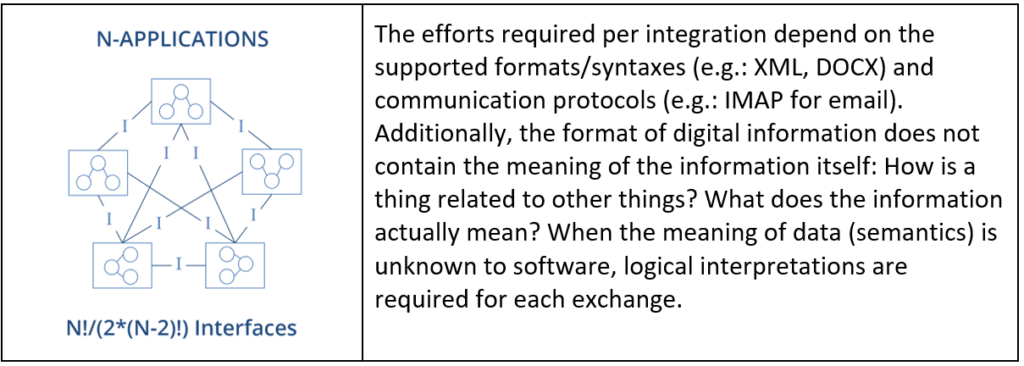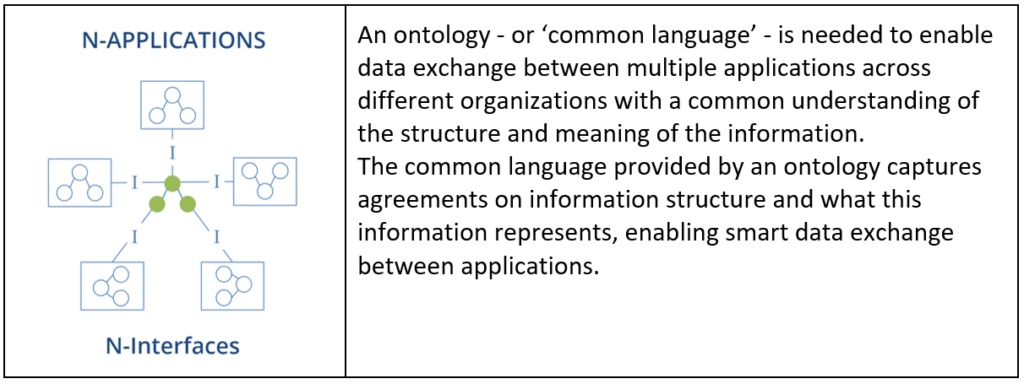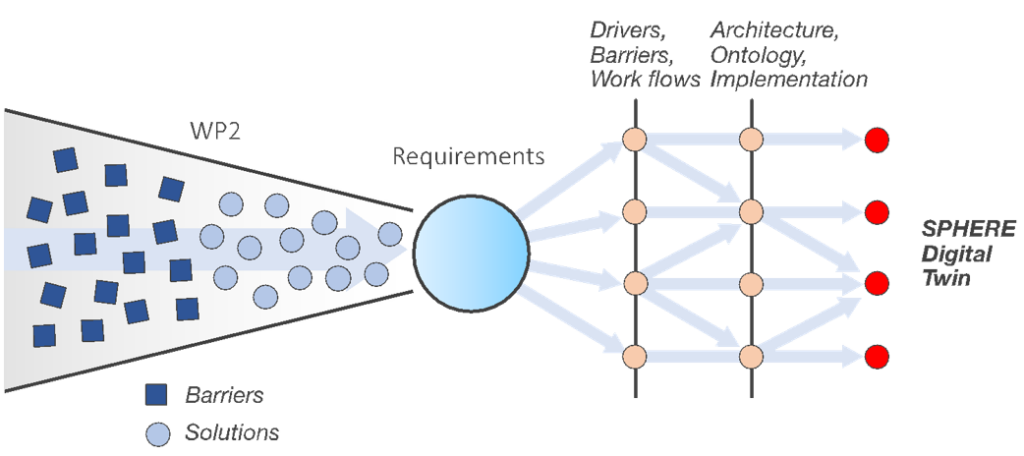SPHERE is a 4-year, Horizon 2020 project that aims to provide a BIM-based Digital Twin Platform to optimise the building lifecycle, reduce costs, and improve energy efficiency in residential buildings.
“A Digital Twin is a dynamic, virtual representation of a building, its assets, processes and systems.”
The SPHERE project pushes the development of a user-friendly SPHERE Platform, an ecosystem integrating services, tools, and solutions from various consortium members together into a Digital Twin. During the four SPHERE pilot projects, information from different sources (e.g., the actual assets, sensor data, simulations) is combined, interpreted, and processed to eventually feed back to the physical building.
Challenges
This kind of interoperability requires information alignment between different information sources such as the 3D model of a building, a network of cameras and a HVAC system with IoT sensors.
As those various sources of information typically serve different main purposes and use cases, their information is unlikely to be aligned. Hence, combining the information requires human interpretations and translations between the different ‘languages’ of the various sources. This leads to costs, information loss and an increased risk of misinterpretation.

Ontology As Common Denominator
Alignment and reasoning challenges transcend individual purposes and thus call for a more generic solution than individual interfaces. They require a higher level of agreement on information structure and semantic description. This can be achieved by agreeing on a domain-independent information structure, or an ontology.
“When two applications are exchanging data, an ontology provides a structure and context to the data, so the applications know the meaning of the data without the need for human interference."
An ontology provides such a level of standardisation that it can be understood by man and machine. As a result, it reduces both the number of transformations needed and the complexity per transformation for connecting information sources regardless of software technicalities or industry. After embracing an ontology, scalability of the resulting interoperable whole is limitless.

Ontology Within SPHERE
SPHERE aims to develop a generic approach to create Digital Twins in the residential housing industry. The adoption of an ontology within the SPHERE development process was a necessary, yet easy, decision in order to achieve a standardised and generic approach. After all, the needs of SPHERE are 100% in line with the main drivers of an ontology:
- Reusability: avoid reinventing the wheel every time you want to exchange data with an application.
- Interoperability: allow the exchange of data between applications across multiple organizations.
- Scalability: when connecting 2 applications or ‘n’ applications, the efforts remain the same.
Hence, since the start of the project, the ontology is part of the definition of the SPHERE platform. The ontology is a cornerstone for the architecture and realisation of the SPHERE ecosystem. To emphasize the concept of an ecosystem, several SPHERE partners are defining a common and Open Digital Twin API[1] (Application Programming Interface) based on the defined ontology.

Ontology Purpose
For the SPHERE project, following description has been defined:
“Ontology is an organizational system designed to classify and to explain the relationships between various concepts of science.”
The most important keywords that are used in the above definition are:
- Concepts: represents a set of ‘things’ within a domain. It is a shared vocabulary that will be used in the domain of the SPHERE ecosystem.
- Relationships: these specify how the concepts are related to each other. By specifying the meaning of relations in a standardized way, adds meaning to data, making it understandable not only for humans, but also computers. The only thing that should be done is connecting the application to the common Open Digital Twin API so data can be exchanged and is understandable for the other application.
Definition of a Digital Twin Ontology
The SPHERE project executed an extensive research to identify multiple available and relevant ontologies. SPHERE studied and listed those according to various selection criteria (e.g., adoption, domain independence and extensibility) and developed a trade-off matrix to select the most appropriate ontologies in the different fields like sensoring, building (assets), and geometry. Based on this research, a decision was made on defining a top-level ontology for the SPHERE project, linking together the Semantic Sensor Network (SSN[2]) and the Building Topology Ontology (BOT[3]). Both ontologies are part of the World Wide Web Consortium (W3C[4]).
In order to add domain specific context and knowledge, SPHERE explicitly chooses to enrich the top model with Object Type Libraries (OTLs) for efficient data exchange.
“An OTL is an information library: a collection of types of objects for use in software applications for various purposes (De Boer et al., 2007).”
An OTL does not describe how information is recorded by computers, but what is recorded by describing types (or concepts). Applied to the context of Digital Twins, the OTL contains different types of building assets, sensors, etc. that will be used in the context of a specific asset. Whether the asset is a house, a building or a bridge, an OTL can be defined in relation to the context and linked to the top model (ontology).
An OTL does not describe the individuals like “this” sensor or “this” room, but rather “a” sensor or “a” room. The purpose of these libraries is enabling the re-use of information in a specific context.
By keeping domain specific information in separate libraries instead of incorporating this in the ontology, gives more flexibility and creates a more sustainable foundation for the future application of the ontology and the according Open Digital Twin API.
If instead all this domain specific information would be included in the ontology at once, the ontology would become too extensive. Every time a new type is defined, the top-level ontology should be extended, leading to developments for software applying the top-level structure. On the contrary, an OTL does not change the structure.
When a top-model and OTL are applied, inter-organisational and application information exchange based on standards like ISO 15926[5] can be achieved. The ISO 15926 is an important standard for SPHERE and serves a significant source of inspiration since it focuses on interoperability within life cycle management of built assets. Applying existing standards and knowledge is a core focus for SPHERE instead of reinventing the wheel. It will support a quicker adoption and maturity in the market.
What’s Next?
The SPHERE project is ambitious concerning interoperability and data management. Hence, it requires a high level of standardisation to make sure the four pilot projects have a generic approach, and the results are reusable in future projects within the industry and by the industry. Developing an ontology is a crucial step in reaching that goal and will evolve in the development of an Open Digital Twin API. That API is a core part of the SPHERE Digital Twin Architecture enabling the ecosystem approach.
In order to enable this ambition, the Building Digital Twin Association (BDTA) was founded. BDTA will continue to develop the project results such as the top-level ontology, domain specific OTL’s and API, when SPHERE ends in 2022.
Written by Peter Imbrechts and Roel De haene from Neanex, Bram Bazuin from Semmtech, and Janne Porkka and Esa Nykännen from VTT
[1] Typically two software applications are integrated making use of an API. Though, every integration requires – a costly – mapping of those respective APIs. SPHERE envisions to define an Open DT API, based on a common ontology.
[2] The Semantic Sensor Network (SSN) ontology is an ontology for describing sensors and their observations, the involved procedures, the studied features of interest, the samples used to do so, and the observed properties, as well as actuators. SSN follows a horizontal and vertical modularization architecture by including a lightweight but self-contained core ontology called SOSA (Sensor, Observation, Sample, and Actuator) for its elementary classes and properties.
[3] The Building Topology Ontology (BOT) is a minimal OWL DL ontology for defining relationships between the sub-components of a building. It was suggested as an extensible baseline for use along with more domain specific ontologies following general W3C principles of encouraging reuse and keeping the schema no more complex than necessary.
[4] W3C is a community in which organisations that have a specific role in the future of information technology such as Microsoft, Apple, Google and IBM participate. The members of W3C 1) jointly lead the way in IT developments, 2) have more knowledge and capacity jointly than individuals, companies and sectors individually and 3) can guarantee the reliability of arrangements (“Use of Open Standards: for Linked Data”, Daan Oostinga). They continuously work on open standards for different industries. The fact that this ontology is initiated from W3C ensures a large installed base together with a full availability as they work on open standards.
[5] The ISO 15926 is a standard for data integration, sharing, exchange, and hand-over between computer systems.